by Winding Pathways | Feb 13, 2025 | Mammals, Nature
Beavers moved into town. Even a large city like Cedar Rapids.
Surprise
An amazing sight greeted us In December 2024, as we walked a circular trail around a tiny unnamed stream in the heart of Cedar Rapids, Iowa. A beaver dam spanned the narrow waterway. Beaver-felled trees lined the bank while bark-peeled branches floated in the still water.
Nearby were two busy roads, houses, and apartment buildings. Tall downtown buildings were just a mile away. So were factories. These beavers are urban.
-

-
Cedar Lake, Cedar Rapids, Iowa.
-
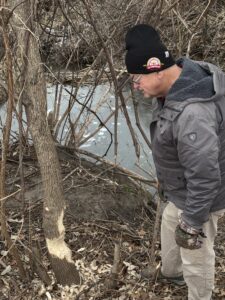
-
A beaver chew next to urban stream.
Urban Beavers
Beavers in a city of 140,000 people! 100 years ago, no one would have imagined that beavers moved into town. But today North America’s largest rodent has moved into cities across the continent. They thrive despite noise and human activity.
Watching City Beavers
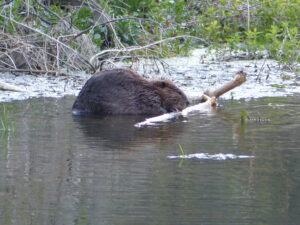
Chewiing
Lots of people enjoy urban birding, and beaver-watching is just as fun. Their territory is easy to find. Fetch a lawn chair, dress warmly, bring binoculars, and perch within sight of beaver activity in the early morning or late afternoon when they’re likely most active.
What to Look For
No animal leaves such visible and durable calling cards as does a beaver family. We walk trails along rivers and often spot trees felled by the sharp teeth and powerful jaw muscles of ambitious beavers. They relish eating the thin nutritious bark covering branches. Beavers leave so much debris around it’s hard to miss finding an active colony.
-
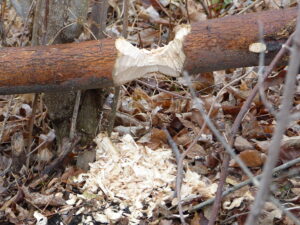
-
chips
-
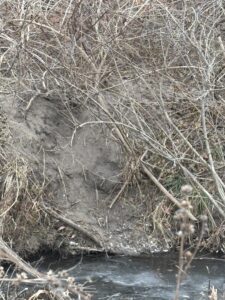
-
Beavers slide
While waiting for beavers to appear keep your eyes peeled. Beavers are a keystone species that alters its environment by cutting trees, digging den holes in the bank, and backing up streams. Their activity attracts many other species, including muskrats, mink, and a host of songbirds that frequent the water’s edge.
An Amazing Resurgence Follows Sad Exploitation
When early Europeans crossed the Atlantic, they found a beaver-filled continent. Experts guess there were somewhere between 60 million and 400 million of the furry animals from coast to coast. That soon changed. European beavers had been hunted and trapped for ages and weren’t common, so newly arrived Americans almost immediately began trapping the huge rodents.
Legendary mountain men combed the Rockies to find plentiful beavers and hundreds of thousands of pelts were shipped eastward in canoes by Canadian voyageurs. Many were shipped to Europe. In the days before synthetic insulation fur kept people warm, and fashionable beaver hats were made from their hair.
Decline and Ethics
The fur trade lasted about 250 years until the late 1800s when the animals had been extirpated from vast parts of their original range. Then came happier news. The value of beaver pelts sank as hats went out of fashion, trees rebounded along streams, and new conservation laws and ethics arose. That started a slow comeback, and now beavers seem to be everywhere.
Two Species
There are two beaver species – the North American and Eurasian. Both are similar but the Old-World species is slightly larger. Each species has made a dramatic comeback. American beavers were released in Finland and Patagonia, where they now thrive as invasive species.
Where Are the Beaver Dams?
Children love reading books about beavers and know that they build dams. Well, not always. These ambitious animals are smart. If their pond, lake, or river is deep enough there’s no need to build a dam. They simply tunnel into the bank to create a home or, sometimes, build a dome-shaped house of sticks and mud that’s usually easy to spot.
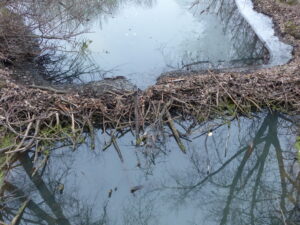
Crossing a small stream.
However, if their stream is narrow and shallow beavers spend nights changing it. They’ll build an amazingly sturdy and often long dam spanning the stream, creating water deep enough for good swimming and hiding a bank tunnel entrance below the surface. Beavers are engineers.
Easy to Watch Urban Beavers
Years ago, beavers were hard to find, even in rural areas. Not anymore. They’re so common in urban areas that people can enjoy them without making a long drive.
by Winding Pathways | Jan 9, 2025 | Labyrinths, Reflections/Profiles, Ruminations
Winter and Spring
Each January I post about visiting labyrinths during the years. Below are Labyrints 2024 that we visited.
January kicked off the year with a fun and moderately mild weather visit to a childhood friend and her family who now live in Wisconsin. We walked in Wauwatosa’s Hartung Park, where the community has installed an engaging labyrinth for all ages to enjoy. Watch as this youngster romped along the path looking for the icicle fairies who feed the Voogans. These are imaginary creatures, tall as a house, who live in the park.
Prairiewoods Spirituality Center in Hiawatha, IA, hosted a series of cross-quarter date labyrinth walks. The first, known in various cultures as Imbolc, St. Bridgit’s Day, or Candlemas, marks the halfway point between the winter solstice and the vernal equinox.
Early April we trekked to Arkansas for the total eclipse and to catch up with Veriditas and Outdoor Writer friends. The paved labyrinth at Hendrix College is special to Twylla Alexander who hosts special walks with her family in the holiday season.
-
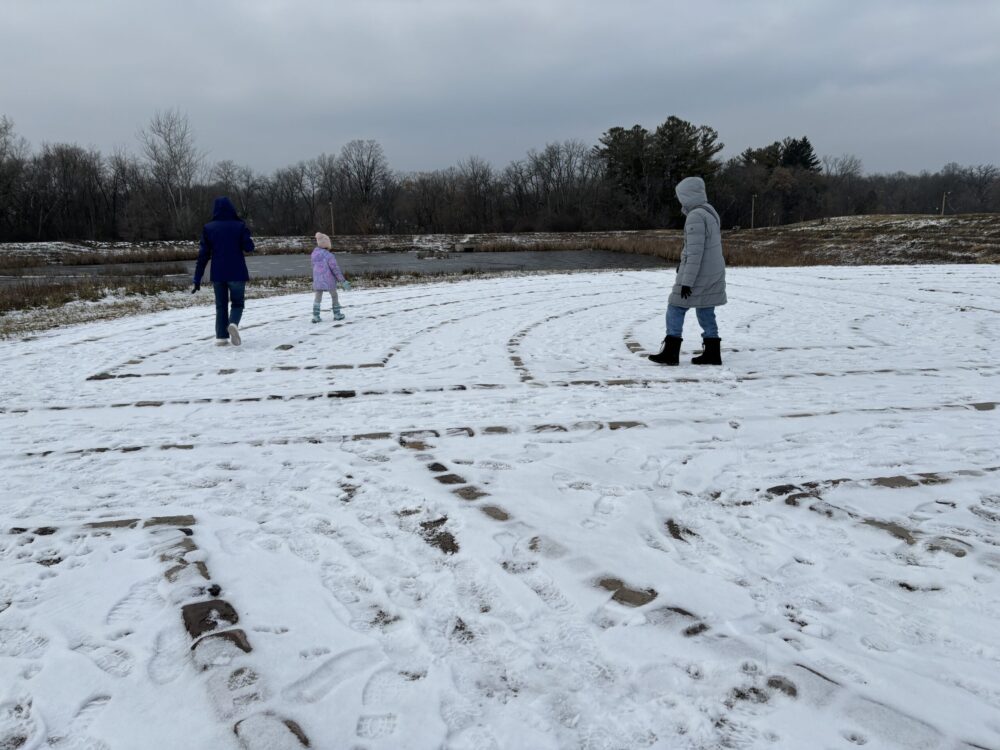
-
Hartung Park, Wauwatosa, WI
-

-
St. Bridgit’s Day Walk
-

-
Twylla Alexander walks the Hendrix College labyrinth, Conway, AR
Spring to Summer
One of my joys is to periodically help host handheld labyrinth walks through Veriditas. Each Friday since March 2020, Veriditas has hosted free walks. As many as 100+ have attended worldwide from at least four different continents. Remember this involves navigating time zones and considering seasonal differences in the Southern and Northern Hemispheres!
December 2023 when I guided a “finger” walk, the North Polar Bear who comes out annually with the Father Christmas stories, jumped up and created quite a stir! Viewers grabbed their Teddy Bears and other “stuffies” and joined in the chaos. I could hardly contain anyone! Soooooo, North Polar Bear set the idea of play in the labyrinth.
This gave rise to the yoga class participants from the Nassif Community Cancer Center coming to the Phoenix Harmony Labyrinth. We’ve walked before and enjoyed a potluck. This year they gamely joined in what is known as the Appleton Dance which works well on a dual-entry five-circuit labyrinth. Laughter and clapping drifted over the yard.
Sometimes a pilgrim quietly arrives. In high summer, a Gazette reporter slowly walked the path, took photos, and sat on the bench in the shade of the birch.
Evening is always a pleasant time to walk, especially with a setting moon to frame the trees. I do miss the sounds of insects which have been diminishing over the years as loss of habitat and increase in sprays take their toll. Insects are critical for earth and human health.
-

-
The North Polar Bear inspired being Playful in the labyrinth
-

-
Adults playing in labyrinth
-

-
Winding Pathways
-
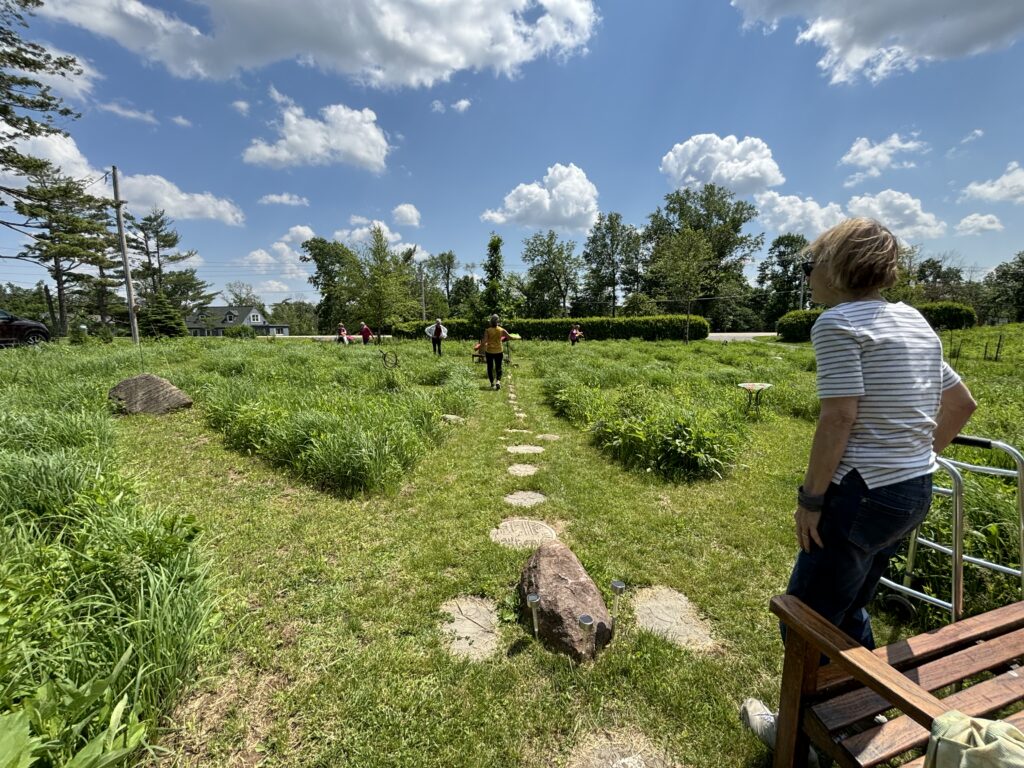
-
Holding space.
-
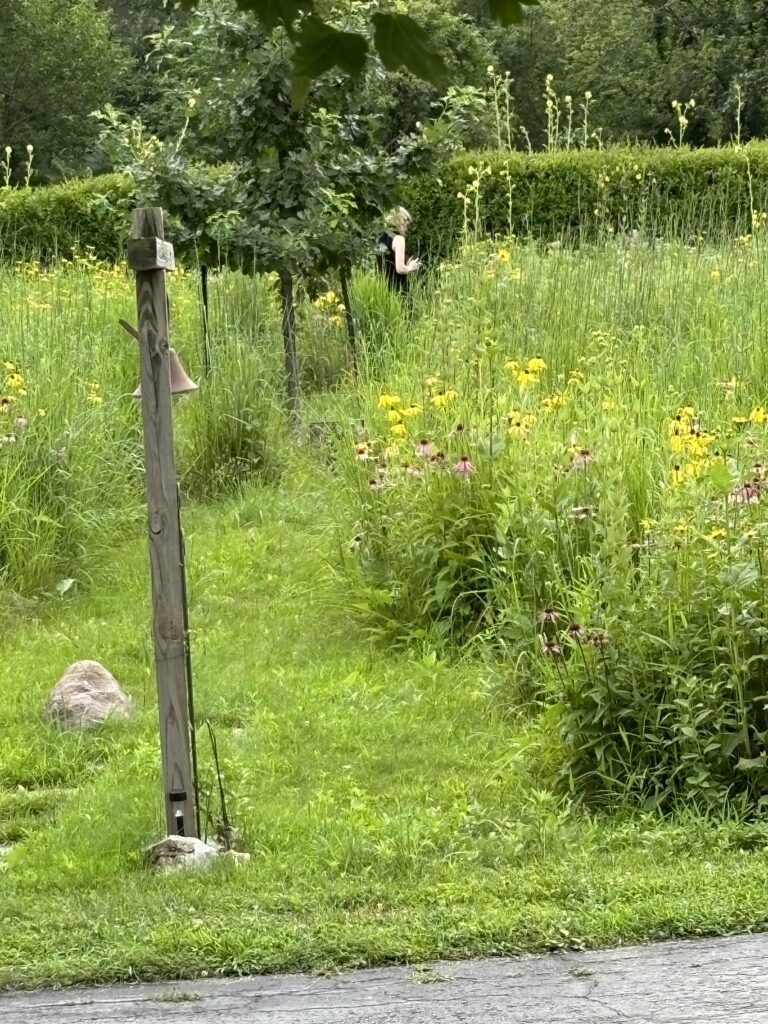
-
Summer charm
-
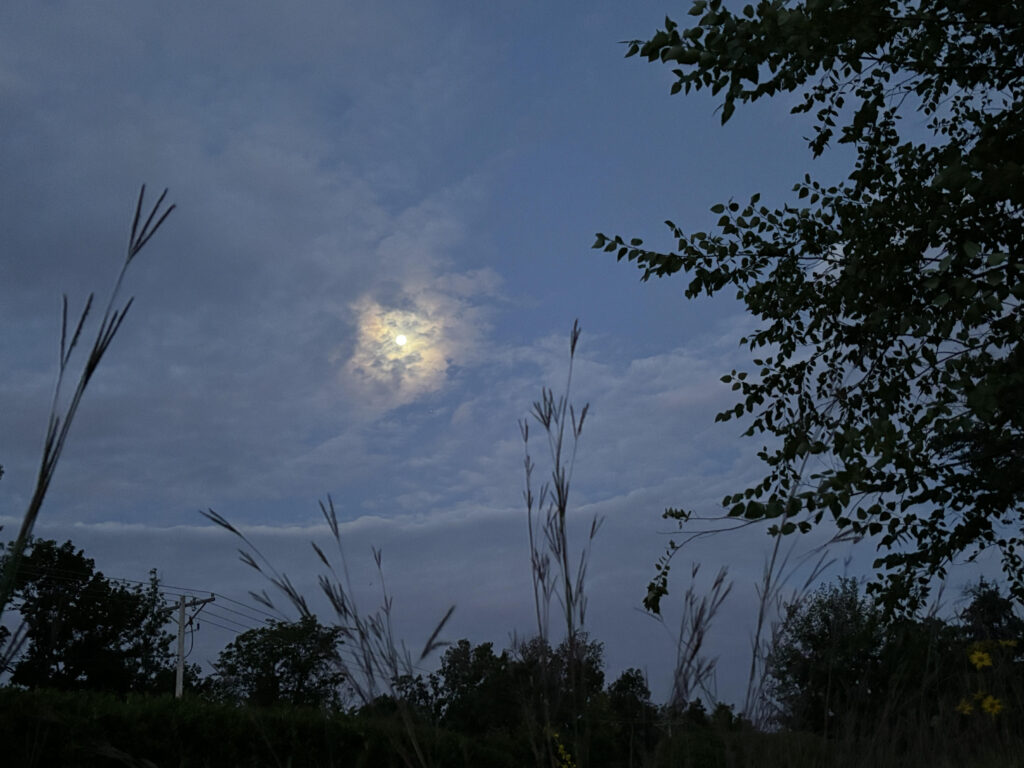
-
Evening walk
Autumn to Winter

Indoor labyrinth
Our minister, the Reverend Carin Bringelson creates unique services engaging a variety of congregants. One September service featured several stops where members engaged in physical activity. This included a three-circuit processional walk that a friend, Tom, helped lay down on the Ely Room floor. We invited people to walk once to get the feel and then again more thoughtfully. People enjoyed the experience and shared their takes on the various stops after service.
Finding labyrinths 2024 was slower this year because of different types of activities.
In September, Rich and I visited Lincoln, NE. Part of our adventure before his bicycle ride was finding labyrinths. It was mostly futile. One was a pretty walking area but not a labyrinth. The other was tucked away from where anyone would choose to walk and behind an area of construction. The path leading to a pretty paved labyrinth was overgrown and uninviting. Needs love. One we simply could not find.
A similar experience in Charles City, IA, which did have a lovely paved labyrinth next to the river revealed that is was gone. To everything, there is a season.
October found me in northern California outside Yosemite at a labyrinth conference. The Gathering’s theme was “Awe and Inspiration.” Indeed the day tour into Yosemite, although brief, yielded a sense of the grandeur of this sacred place so loved by John Muir and before him, the Indigenous people who lived there.
We are not always filled with Awe and Inspiration, so what do we do when things are tough? We walk through “Ordinary” time. Not meaning dull, but time of preparation. Although connected to the liturgical sense, we all experience “Ordinary” time and Awe and Inspiration. That was the theme of my talk. How inspiring to hear people’s experiences and how they use the labyrinth to help them keep balance and return to a sense of appreciation and inspiration.
I’ve captured images of our trip below.
-

-
Sacred Space
-

-
Enjoying the climbers on El Cap. Can you spot them? In the Heart of El Capitan
-

-
Beth Sharing music
-

-
Unique
-

-
New labyrinth
-
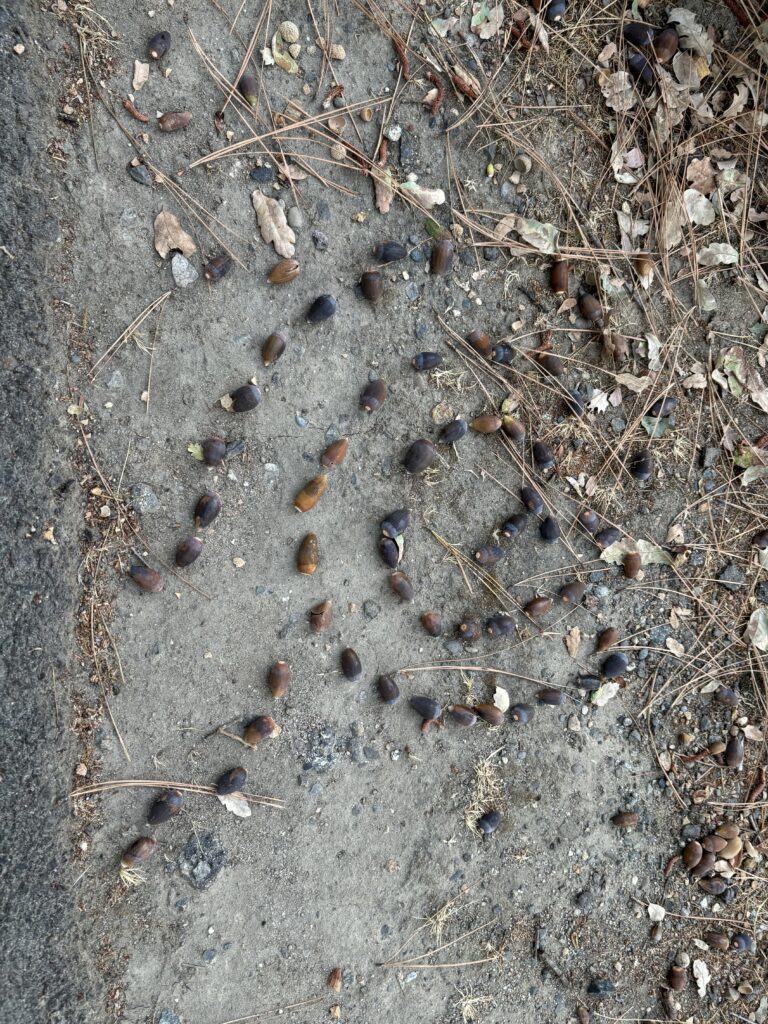
-
Labyrinths everywhere
Finally, we approach winter with our final yard task of the year. Burning the prairie and the labyrinth! My favorite activity. Now, I can walk the path, note the ashen borders, and know that come spring the Phoenix Harmony Labyrinth will emerge even more robust than ever.
-

-
Early Spring from porch
-
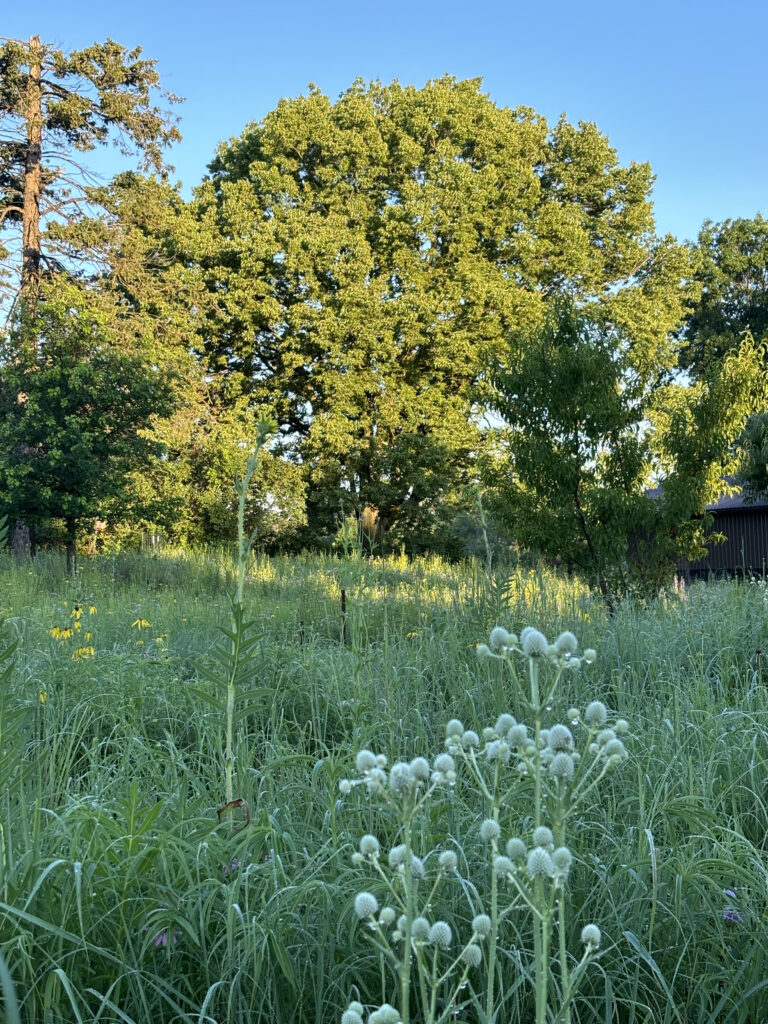
-
Summer fullness
-
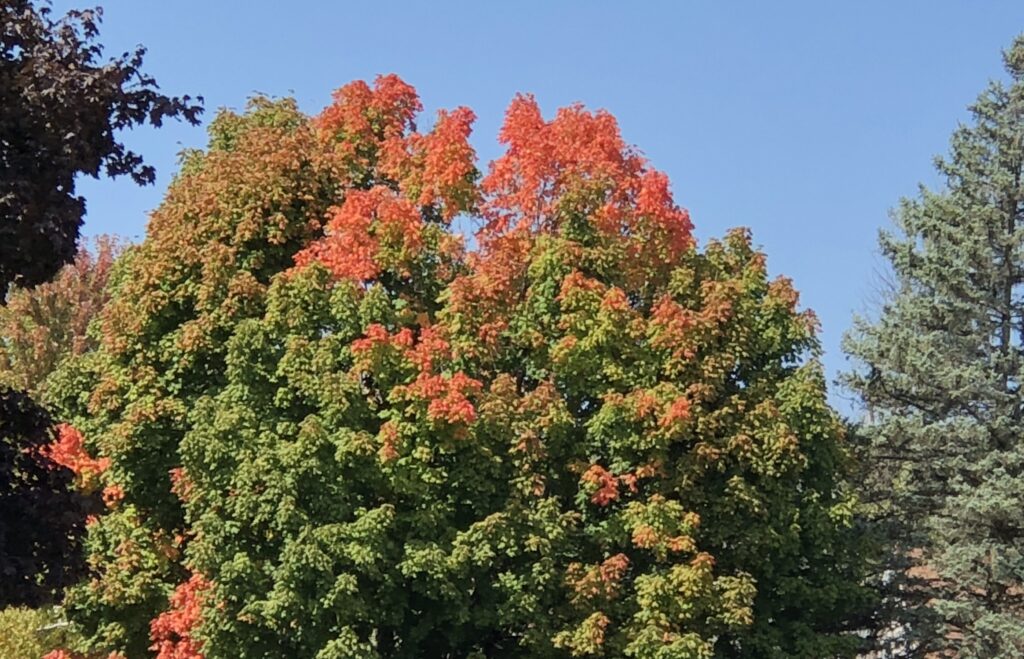
-
Fall color
Burning and winter quiet.
-
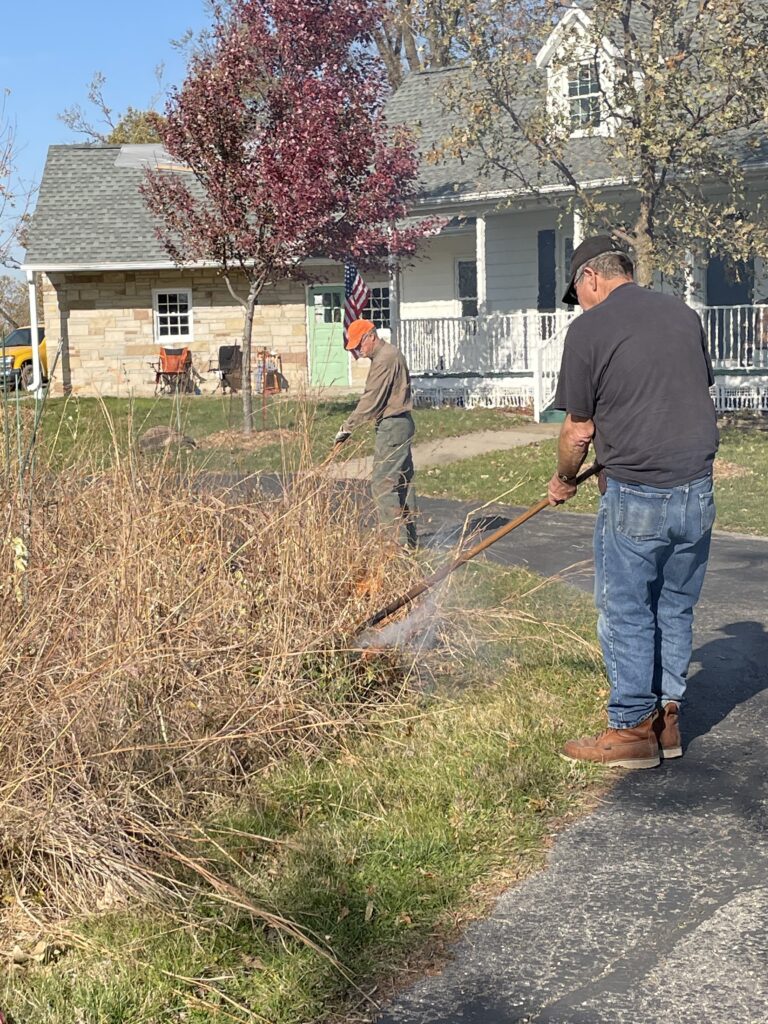
-
Moving fire into new fuel.
-

-
Rake in hand
-
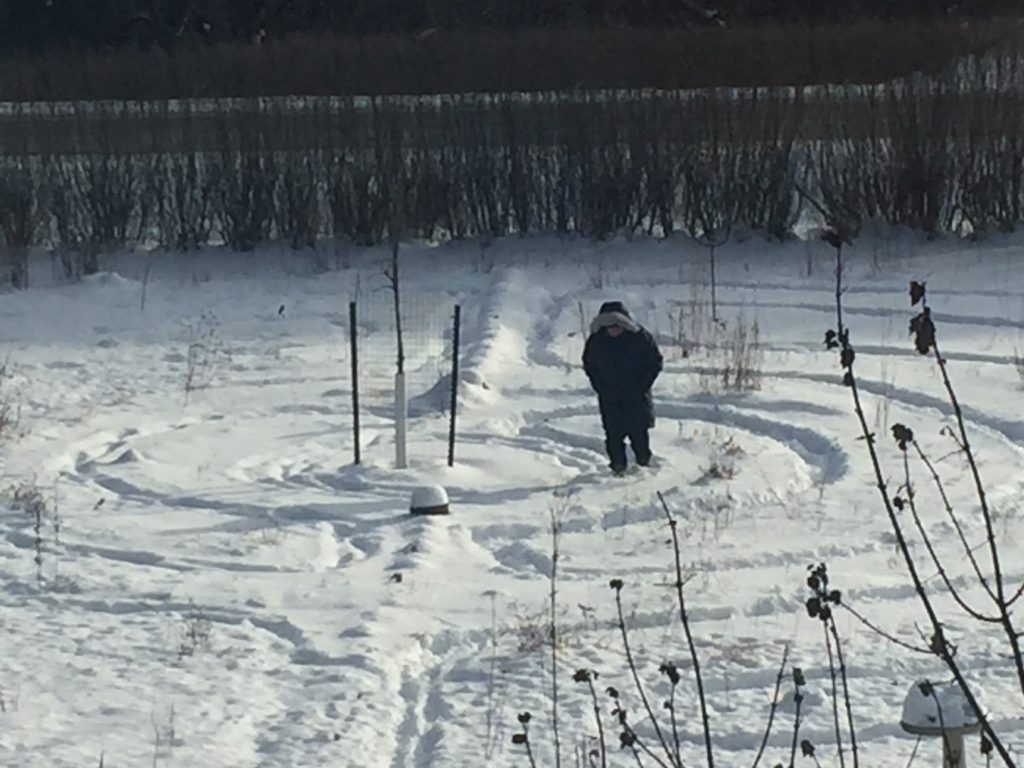
-
Walking in winter
by Winding Pathways | Jan 2, 2025 | Travel/Columns
Features: 2020 – 2024
2024
(For a list of features go to https://www.thegazette.com/marion-and-rich-patterson/)
For related articles click here.
November 10, 2024. Riding the (t)Rails. (in print copy and Green Gazette)
November 3, 2024. Land of the Dawn.
October 23, 2024. Getting the Lead Out.
August 4, 2024. Washington’s Tri-Cities Region….
July 30, 2024. How Three Iowa Lands Became Home to Restored Prairie. Feature by Bailey Chichon about our work in restoration.
June 9, 2024. Heading South to View the Eclipse….
April 7, 2024. Trave: Wild Winter Wonderland (Alaska in winter)
January 28, 2024. Wandering Pennsylvania’s Wilds
January 15, 2024. Shed Hunting Season
-

-
Safe viewing
-

-
Highlight of a unique trip.
-
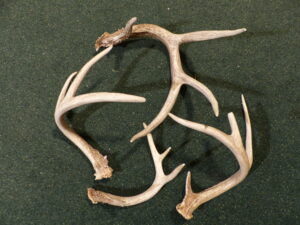
2023 – 2022
December 10, 2023. Breathtaking Views (firetowers)
September 10, 2023. Peaceful Prairie (Grasslands of Saskatchewan, CAN)
August 5, 2023. Fly Fishing. (no link to date. Available Green Gazette)
July 16, 2023. Intriguing Riddles From the Hopewell Culture.
May 29, 2023. Head for The Hills. (Black Hills off Season)
May 21, 2023. Moving Heaven and Earth. (Earth Moving Legacy Museum)
May 5, 2023. Ax Throwing: a Fun Historic Skill.
April 2, 2023. Agritourism Attraction. (Fair Oaks Farms)
March 5, 2023. Seeking Independence. (Truman Presidential Library)
February 3, 2023. A Gem in Pennsylvania’s Laurel Highlands.
January 6, 2023. Ike’s Town. Abilene, Kansas & Western History.
December 4, 2022. Trap Shooting.
September 6, 2022. Riding the Rails (Alaska by Train)
July 17, 2022. Backyard Adventures. (No link to date)
July 11, 2022. Casper, WY, Gateway to the West.
May 12, 2022. Hobo Convention.
May 8, 2022. Splish Splash! Whitewater Kayaking in Iowa. (No link to date)
April 22, 2022. Finding America On Roadways East.
April 13, 2022. Muscle Over motor When Boating.
March 21, 2022. Rockhounding.
January 30, 2022. Backpacking Bonus. (8B of GZ. No link to date) Available Green Gazette.
January 24, 2022. Distinctive Religious Structures.
January 16, 2022. Hiking Wild Areas. (no link to date) Available Green Gazette.
-

-
A favorite spot in the Black Hills
-

-
View of an iconic Cedar Rapids church.
-

-
A grand time in Britt, Iowa
2021-2020
December, 2021. Country Schools. (no link to date) Available Green Gazette
November 15, 2021. Making a (Mini) Pitch for Soccer.
October 6, 2021. A visit with Midwest’s Pioneering Authors.
September 8, 2021. Taking a Slow Boat to Cassville.
September 6, 2021. Camping in Iowa’s Trout Country & Decorah’s Celebrities.
August 4, 2021. Parking While Headed East. And Solar Panels at Peoples.
June 13, 2021. Alaska Recreation.
May 22, 2021. Museums of Quad Cities Area. https://www.thegazette.com/recreation/the-many-museums-of-the-quad-cities/
April 18, 2021. Finding Amelia. https://www.thegazette.com/recreation/an-unexpected-search-for-amelia-earhart/
April 11, 2021. Mississippi river Museum and Dubuque
March 25 , 2021 Cedar Falls_Waterloo. Memorable Museums
March 12, 2021. Time Travel. https://www.thegazette.com/subject/sports/outdoors/time-traveling-in-iowa-20210312
March 3, 2021 Entering the Battery Age (column)
February 19, 2021. Franconia Sculpture Park. https://www.thegazette.com/subject/sports/recreation/art-walk-in-a-park-20210219
February 2, 2021. Sprint Cars. https://www.thegazette.com/subject/sports/auto-racing/a-sprint-car-education-20210202
January 14, 2021. Embrace the Outdoors. https://www.thegazette.com/subject/sports/outdoors/embracing-x2014-and-enjoying-x2014-the-cold-outdoors-20210114
-

-
Sunset over Cook Inlet.
-
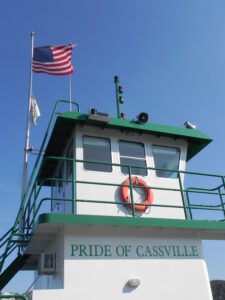
-
A short ride short to shore.
-
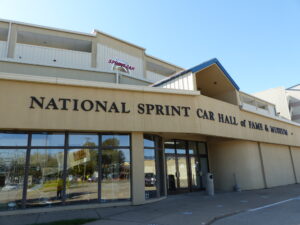
-
A popular sport in Iowa.
*****
December 20, 2020. Walking Cemeteries. https://www.thegazette.com/subject/sports/outdoors/a-peaceful-outdoor-walking-option-20201221
December 14, 2020 Iowa Meat Lockers: https://www.thegazette.com/subject/sports/outdoors/a-meaty-adventure-20201214
Nov 11, 2020 Iowa’s Inland Seas. https://www.thegazette.com/subject/sports/outdoors/enjoying-iowas-inland-seas-20201111
Oct 11, 2020. Barn Quilts. https://www.thegazette.com/article/barn-quilts-offer-brighten-up-the-countryside/
Sept 27, 2020: New Life to Dead Trees. https://www.thegazette.com/subject/sports/outdoors/dead-trees-give-life-20200927
September 20, 2020: Walk Outside Safely. https://www.thegazette.com/subject/sports/outdoors/get-outside-and-walk-but-stay-safe-20200920
September 9, 2020: Rebirth Amid the Rubble https://www.thegazette.com/subject/sports/outdoors/a-rebirth-among-the-rubble-of-trees-20200906
August 22, 2020: Iowa’s National Parks. https://www.thegazette.com/subject/sports/outdoors/iowa-national-parks-guide-effigy-hoover-20200822
July 27, 2020: County Parks. https://www.thegazette.com/subject/sports/outdoors/take-advantage-of-iowas-county-gems-20200727
July 11, 2020: Tenting. https://www.thegazette.com/subject/sports/outdoors/why-rv-live-isnt-for-these-senior-tent-campers-20200711
June 26, 2020: Bear Sightings in Iowa: https://www.thegazette.com/subject/sports/outdoors/why-rv-live-isnt-for-these-senior-tent-campers-20200711
April 12, 2020” Walk on Wilder side. https://www.thegazette.com/subject/sports/recreation/take-a-walk-on-the-wilder-side-20200412
-
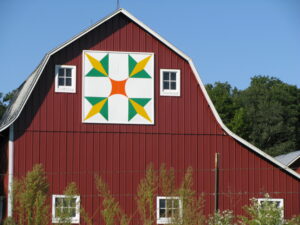
-
Iowa’s Barn Quilt Trails are fun to take.
-
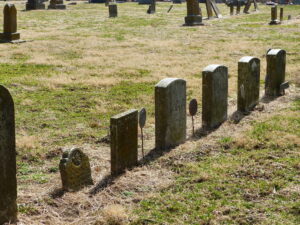
-
Some Union Some Confederates
-
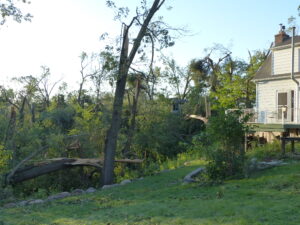
-
Felled trees.
by Winding Pathways | Dec 26, 2024 | Flowers/Grasses, Trees/Shrubs
Historic Background and Reason For Prescribed Burning
After the glaciers retreated over 9,000 years ago fires swept across much of North America, set by Native Americans and occasionally started by lightning. Fire created the vegetation and wildlife Europeans found during settlement and westward expansion.
Europeans disdained and feared fire. They suppressed it while introducing many invasive exotic plants. This has created a forest landscape of large trees with an understory of shade-loving exotic vegetation in place of former savannas.
Europeans didn’t understand nor appreciate varied ecosystems like prairies. Even as farmers and ranchers used the open lands for crops and grazing, little did they realize the importance of fires. Fires sweeping across prairies invigorate grasses and wildflowers while killing any brushy plants that try to move in.
What Fire Favors:
- It tends to favor grasslands over forests.
- It tends to create and maintain savannas.
- It tends to favor native over exotic vegetation.
- It tends to favor some native tree species over others. In general, trees that produce large nuts, such as oaks, hickories, and walnuts tend to be fire-resistant or dependent. Trees that create small seeds, such as elms, ashes, and maples tend to be fire-tender. The impact of repeated fires shifts dense woodlands to savannas dominated by oak and hickory and, in drier areas, prairies.
-
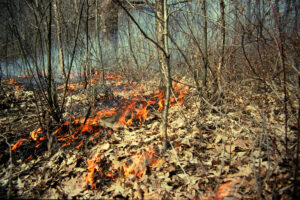
-
A cool forest burn
-
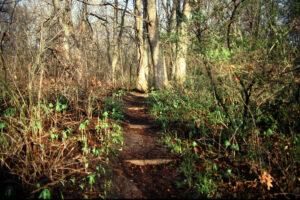
-
Burns open up sunlight for spring ephemerals.
Impact of Prescribed Burns on Prairies
Prescribed burning tends to:
- Remove insulating dead grasses, allowing the sun to warm the soil. This, favors warm season prairie plants.
- Create ash, which enriches the soil by recycling nutrients.
- Stimulate native species.
Note: burning in fall tends to favor forbs (wildflowers) while early spring burning favors prairie grasses.
Safety for Persons Conducting Burns
- Have a fire permit and adhere to its requirements.
- Wear natural fiber clothing, leather gloves, and sturdy boots.
- Understand fire behavior. See below.
- Stay out of unburned fuel and know where safe locations are. Safe locations include already burned areas, paved or gravel surfaces, and mowed lawns.
- Understand a clear burn plan as presented by the coordinator and follow directions.
- Be aware of where all people are during the burn.
- Have a cell phone with the number of the fire department programmed in.
- Have appropriate fire management tools handy and a first aid kit.
- Know about how to survive should one be “caught” by a fire.
- Be aware of “defense in depth”. (Have a second location to hold a fire should it get out of control.)
-
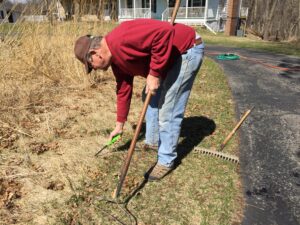
-
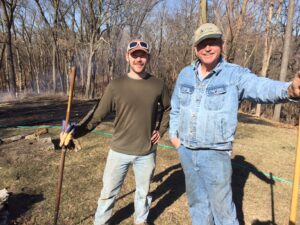
-
Mentoring younger fire managers.
Fire Behavior
Fires behave based on three factors: Fuel, Topography, and Weather.
Fires tend to burn faster:
- Upslope rather than on the flat or downhill.
- With the wind.
- With low humidity.
- With dry fine fuel.
Knowing these tenets of fire behavior helps plan burn strategy. For example, if the humidity is low, wind is moderate, and fuel is dry and fine it may be prudent to burn slowly into the wind or downslope. However, if the humidity is high and the wind is low it is likely prudent to burn with the wind, after creating a safe firebreak. These assume flat terrain.
-
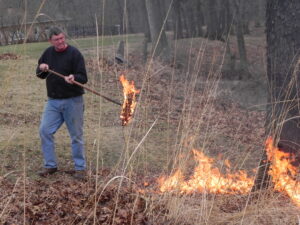
-
Rich moves fire to new fuel.
-
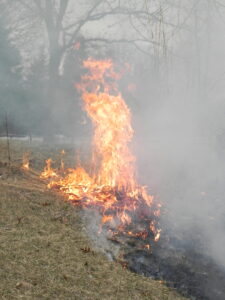
-
Burn Against Wind
A skilled person planning a prescribed burn considers all these factors before striking a match and conducts the fire most prudently.
Conducting a prescribed burn is one of the most effective ways to restore a semblance of America’s traditional vegetation.
-
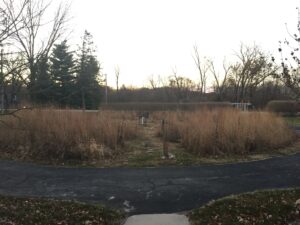
-
Pathways and prairie grasses.
-
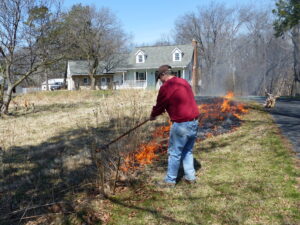
-
Stand out of fuel.
-

-
Dark soil warms the earth.
by Winding Pathways | Dec 5, 2024 | (Sub)Urban Homesteading, Energy Efficiency, Garden/Yard, Garden/Yard
*Note: Below are just a few examples of several power tools we’ve purchased. They were pricey but made yard work so much easier than with muscle-powered tools. Occasionally, a company asks us to try a product and give reviews.
Yard work was a snap when we were in our 20s. That was a half-century ago! How can that possibly be? Years slipped by. We’re just as eager to mow grass, rake leaves, plant gardens, prune shrubs, and shovel snow, but muscles and joints make the work challenging. Fortunately, we’ve found ways to make yard work and house repairs easier for us as aging homeowners. People with reduced strength or mobility and even younger people with busy schedules will find these tips handy.
Here are some ways we’ve made yard management easier:
Invest in Tools
Tool companies have made yard care easier and safer than in the old days. We used to use muscle-powered tools to trim hedges and shrubs, cut and split wood, rake leaves, move snow, and till the garden. As we got older we began investing in power tools that make the work easier and faster.
For example, an old fashioned “weed wacker”, powered by arm muscles, cut down tall grass growing into pathways and our woods. That got harder each year, so we invested in a Milwaukee brand battery-powered tool that fuels a weed cutter, pole saw, and hedge trimmer. The work is quick and easy. Same with our lopping shears for trimming trees. A battery-powered pruner does the tough cutting easier than hand muscles.
-
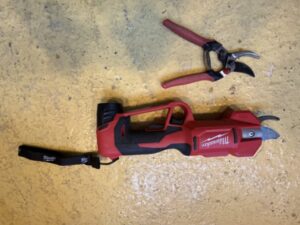
-
spring loaded vs battery
-
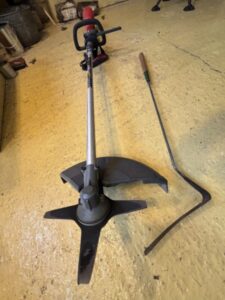
-
Long handle
-
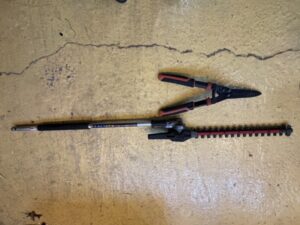
-
Muscle powered shears next to hedge trimmer.
We always had a gas lawn mower but often struggled to pull the darn starter cord. When EGO came up with a battery-powered mower we eagerly bought one and got rid of the old gas mower. The EGO starts by pushing a button, and it’s self-propelled. We have to walk behind and guide it, but it chugs along under its own power. That’s especially helpful when we mow trails on our hillside.
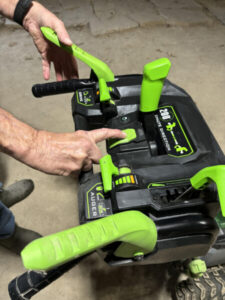
The EGO snowblower starts with a push of a button.
Snow shovels! Well, we still have a few and use them in tight spaces, but our relatively new battery-powered snow blower makes clearing our 440-foot driveway a snap and eliminates the need to lift heavy snow and pull a starter cord.
Those are just a few examples of several power tools we’ve purchased. They were pricey but made yard work so much easier than with muscle-powered tools.
Hiring and Borrowing
This past season we did a “first”. We hired a young woman to help with gardening. And, we sometimes hire a local teenager to mow our lawn. Years ago we wouldn’t have dreamed of hiring anyone to do what we could do. That’s changing. Having extra hands to help is money well spent.
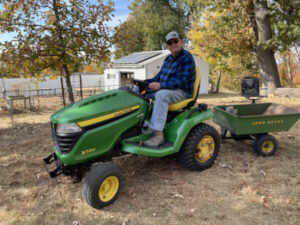
The tractor made hauling wood easier.
It’s not always hiring help. We swap. By late October Rich had cut and split a small mountain of cordwood we’ll use to stay warm this winter. There was a problem. It was on the north side of our property and down a steep hill. In past years he’s hand carried it uphill. Not a small task to muscle 2000 pounds of wood in 50 round trips carrying 40 pounds up the hill each time. Whew. This year a neighbor came to our rescue. Rich borrowed his tractor and trailer and moved all the wood up the hill in a jiffy. From time to time, we have loaned him some of our tools in exchange. Borrowing works both ways.
We pride ourselves on our independence and take joy in yard work, but we just turned 75 and aren’t quite as frisky as we once were. Using power tools, hiring help, and cooperating with neighbors all make keeping up with the yard easier.






















































